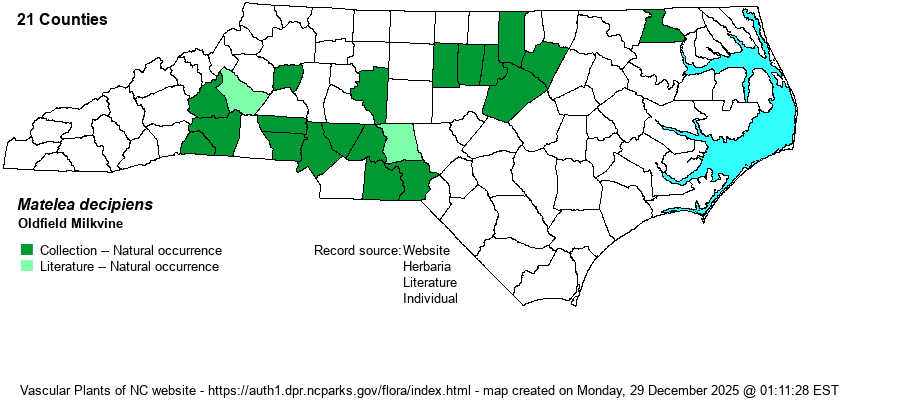| Author | (Alexander) Woodson | |
| Distribution | The account below is for what is now (summer 2025) known as "Matelea decipiens", which Weakley (2024) says: "Previous reported distribution eastwards in VA south to nc. GA and ne. MS appears to represent variability within M. caroliniensis (Fishbein & McDonnell 2023)".
True M. decipiens occurs from "S. IL, c. MO, and se. KS south to LA and e. TX." (Weakley 2024). | |
| Abundance | Rare to locally uncommon in the Piedmont, and extremely rare in the northern Coastal Plain. Populations are mostly clustered in the northeastern Piedmont (especially in Granville and Durham counties) and in the southern tier of counties -- from the base of the Blue Ridge Escarpment on the west to Richmond County on the east. In late 2024, the NCNHP followed Weakley in considering this taxon to now not be present in NC, with a State Rank of SNA (Not Applicable); the editors have included the SRF = Reported Falsely subrank. Even though the NatureServe rank is G5, there is concern that what we have in NC might no longer be true "decipiens", as mentioned in Distribution. | |
| Habitat | This "species" is essentially restricted to circumneutral (high pH) soils, but mostly in dry conditions. It occurs in mafic glades and barrens, along the margins and in openings of Basic Oak-Hickory Forests, in powerline clearings, and other partly sunny to mostly sunny places. It can be found in more mesic sites, but the very similar M. carolinensis favors these mesic to rich sites. |
| Phenology | Blooms from April to June, and fruits from August to October. | |
| Identification | This form is an herbaceous vine that climbs over other vegetation to a length of 6 feet or more. It has scattered opposite leaves that are heart-shaped to widely ovate, like many other vine species. The leaves are about 5 inches long and 3-4 inches wide, being pointed at the tip and cordate at the base. The stems and petioles are normally very hairy/hirsute, as often are the leaves, rather than the somewhat glabrous stems, petioles, and leaves as seen in M. carolinensis. In leaf axils grow the flower clusters, usually 10-15 or more flowers in a cluster, as opposed to mainly 5-8 flowers in the other species. The flowers, a maroon-purple in color, normally have strongly ascending petals, and the petals are usually 3-6 times longer than wide, as opposed to shorter petals in M. carolinensis, which has petals mainly just 2-2.5 times as long as wide. All Matelea species have spiny, rough pods and these are not normally useful in separation, as opposed to flower number and shape. Another character used in separation of the two species is that the flowers, when in bud, form a narrow conical shape, as opposed to a shorter and more rounded flower bud in M. carolinensis. The usual habitats of the two typically differ, as M. decipiens is a strong "obligate mafic" species, found only on high pH soils and almost always in dry to xeric conditions, such as glades and barrens, and along margins of dry woods. Unfortunately, plants are seen in mesic habitats that simply are troubling to identify! This species can be found in quite a few natural areas in the Piedmont that protect rare natural communities and rare "prairie plant" species. | |
| Taxonomic Comments | See Distribution. Many Carolina botanists have noticed that there is indeed variability in this complex -- in dry and often more mafic sites that plants are more hairy and have more flowers than those in more shaded and richer sites, but with a gradation of characters in more mesic and partly shaded places.
| |
| Other Common Name(s) | Climbing Milkweed, Deceptive Spinypod | |
| State Rank | SRF | |
| Global Rank | G5 | |
| State Status | | |
| US Status | | |
| USACE-agcp | | |
| USACE-emp | | |

